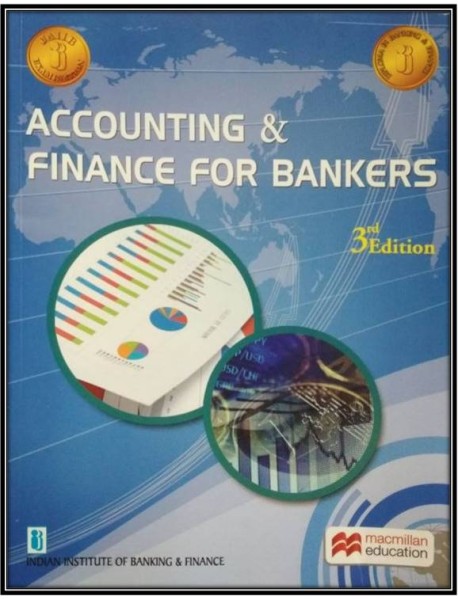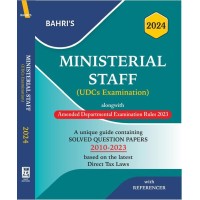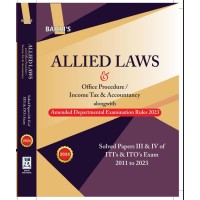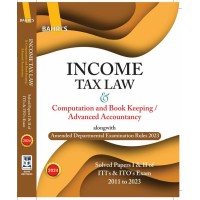ACCOUNTING & FINANCE FOR BANKERS (JAIIB)
ACCOUNTING & FINANCE FOR BANKERS (JAIIB)
- Brand : MACMILLAN PUBLISHERS
- Product Code : VBH000148
- Availability : 10
-
Rs440.00
- Ex Tax :Rs440.00
3RD EDITION
PAPER 2-ACCOUNTING &FINANCE FOR BANKERS
MODULE -I BUSINESS MATHEMATICS AND FINANCE
Calculation of Interest and Annuities
on Simple Interest & Compound Interest: Calculation of Equated Monthly Installments Fixed and
Floating Interest Rates: Calculation of Annuities: Interest Calculation using Products
of a Debt; Sinking Funds
ebt. Definition, Meaning & Salient Features: Loans: Introduction to Bonds: Terms associated with Bonds:
Cost of Debt Capital: Bond value with semi-annual Interest: Current Yield on Bond: Calculation or to
Maturity of Bond: Theorems for Bond Value: Duration of Bond: Properties of Duration: Bond Price Volatility
Capital Budgeting
Present Value and Discounting: Discounted Technique for Investment Appraisal: Internal Rate of Return (IRR):
Method of Investment Appraisal; NPV and IRR compared; Investment Opportunities with Capital Rationing:
Investment Decision making under condition of uncertainty: Expected NPV Rule, Risk Adjusted Discount
Rate Approach for NPV Determination; Sensitivity Analysis for NPV Determination: Decision Tree Analysis
for NPV Estimation: Payback Methods: ARR.
Depreciation and its Accounting
Depreciation, its types and methods: Comparing Depreciation Methods
Foreign Exchange Arithmetic
Fundamentals of Foreign Exchange: Forex Markets: Direct and Indirect Quote: Some Basic Exchange Rate
Arithmetic - Cross Rate, Chain Rule, Value date, etc.; Forward Exchange Rates Forward Points: Arbitrage:
Calculating Forward Points: Premium/discount, etc.
MODULE B - PRINCIPLES OF BOOKKEEPING & ACCOUNTANCY
Definition, Scope and Accounting Standards
Nature and Purpose of Accounting: Historical Perspectives: Origins of Accounting Principles: Accounting
Standards in India and its Definition and Scope: Generally Accepted Accounting Principles of USA
(US GAAP): Transfer Pricing: Overview of IFRS: Difference between GAAP & IFRS.
Basic Accountancy Procedures
Concepts of Accountancy: Going Concern Entity: Double Entry System: Principle of Conservatism: Revenue
Recognition and Realisation; Accrual and Cash Basis.
Maintenance of Cash/Subsidiary Books and Ledger
Parod Keeping Basics; Account Categories, Debit and Credit Concepts: Accounting and Columnar Accounting
Mechanics: Journals; Ledgers: subsidiary books: ete.
Bank Reconciliation Statement
Need for Bank Reconciliation: Causes of Differences, Preparation of Bank Reconciliation Statement: How
to prepare a Bank Reconciliation Statement when Extracts of Cash Book and Pass Book are given, Adjusting
the Cash Book Balance: Advantages of Bank Reconciliation Statement.
of Trial Balance and Preparation
ation of Errors: Rectification
e closed; Adjusting and
Revenue Expenditure: Receipts;
Trial Balance, Rectification of Errors and Adjusting & Closing Entries
Meaning of a Trial Balance: Features and Purpose of a Trial Balance; Types of Trial Balan
afa Trial Balance; Disagreement of a Trial Balance; Classification of Errors: Location of Era
of Errors: Suspense Account and Rectification: Rectification of Errors when Books are close
Closing Entries
Capital and Revenue Expenditure
Expenditure: Distinction between Capital and Revenue Expenditure; Deferred Revenue Expenditure
General Illustrations.
Bills of Exchange
Types of Instruments of Credit: Term and Due Date of a Bill: Certain Important Terms: Acco
to be Passed: Accommodation Bill etc.
in Important Terms; Accounting Entries
MODULE C - FINAL ACCOUNTS
Balance Sheet Equation
Balance Sheet Equation; Computation of Balance Sheet Equation.
Preparation of Final Accounts
Preparation of Trading A/C: Profit and Loss A/C: Profit & Loss Appropriation Account; Balance Sheets
Ratio Analysis
Meaning of Accounting Ratios; Classification of Ratios; Uses of Accounting Ratios: Limitations of Acco
Ratios: Calculation and interpretation of various Ratios; Different Users and their Use of Ratios.
Final Accounts of Banking Companies
Definition and Functions of a Bank; Requirements of Banking Companies as to Accounts and Audit; Significant
Features of Accounting Systems of Banks: Principal Books of Accounts; Preparation and Presentation of
Financial Statements of Banks: CMA Format; Accounting Treatment of Specific Items; Preparation of Profit
and Loss Account; Comments on Profit and Loss Account; Important Items of Balance Sheet; Disclosure
Requirements of Banks: Additional Disclosures prescribed by RBI: Disclosures required under BASEL norms
Company Accounts I & II
Definition and Types of Companies: Distinction between Partnership and Limited Liability Company: Classes
of Share Capital; Issue of Shares: General Illustrations
Non-voting Shares; Form of Balance Sheet: Legal Requirements for Assets: Legal Requirements for Liabilities:
Legal Requirements for Profit & Loss Alc; Preparation of Final Accounts
Accounting in a Computerized Environment
Meaning, Features of and Terms used in Computerized Accounting: Difference between Computerized and
Manual Accounting: Advantages and Disadvantages of Computerized Accounting: Functions performed by
Computerized Accounting Softwares available in the Market: Computerization - Scope and Experiences in
Banking: The Core Banking Components: Information Security: Internet and World Wide Web -- Influences
on Banking
MODULE D - BANKING OPERATIONS
Banking Operations & Accounting Functions
Preparation of Vouchers, cash receipt and payment entries, clearing inward and outward entre
debit and credit entries, what is KYC and what are the different documents to satisfy KY V
duthenticity of documents, operational aspects in regard to opening of all types of accounts, su
Ppications/documents, allowing drawals and accounting entries involved at various stage
S environment etc.. Back office operations in banks, handling of unree
outward entries, transfer
STY KYC, verify KYC and
nis, scrutiny of loan
us stages, operational
moming of unreconciled entries in banks




